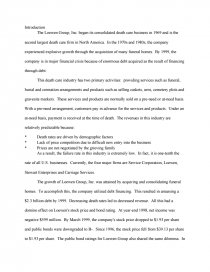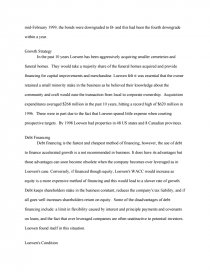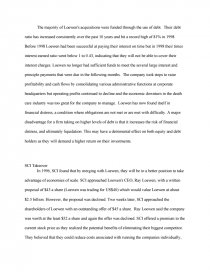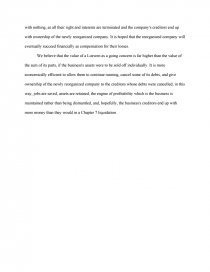The Loewen Group, Inc
Essay by review • February 15, 2011 • Case Study • 1,362 Words (6 Pages) • 2,257 Views
Introduction
The Loewen Group, Inc. began its consolidated death care business in 1969 and is the second largest death care firm in North America. In the 1970s and 1980s, the company experienced explosive growth through the acquisition of many funeral homes. By 1999, the company is in major financial crisis because of enormous debt acquired as the result of financing through debt.
This death care industry has two primary activities: providing services such as funeral, burial and cremation arrangements and products such as selling caskets, urns, cemetery plots and gravesite markers. These services and products are normally sold on a pre-need or at-need basis. With a pre-need arrangement, customers pay in advance for the services and products. Under an at-need basis, payment is received at the time of death. The revenues in this industry are relatively predictable because:
* Death rates are driven by demographic factors
* Lack of price competition due to difficult new entry into the business
* Prices are not negotiated by the grieving family
As a result, the failure rate in this industry is extremely low. In fact, it is one-tenth the rate of all U.S. businesses. Currently, the four major firms are Service Corporation, Loewen, Stewart Enterprises and Carriage Services.
The growth of Loewen Group, Inc. was attained by acquiring and consolidating funeral homes. To accomplish this, the company utilized debt financing. This resulted in amassing a $2.3 billion debt by 1999. Decreasing death rates led to decreased revenue. All this had a domino effect on Loewen's stock price and bond rating. At year-end 1998, net income was negative $599 million. By March 1999, the company's stock price dropped to $1.93 per share and public bonds were downgraded to B-. Since 1996, the stock price fell from $39.13 per share to $1.93 per share. The public bond ratings for Loewen Group also shared the same dilemma. In mid-February 1999, the bonds were downgraded to B- and this had been the fourth downgrade within a year.
Growth Strategy
In the past 10 years Loewen has been aggressively acquiring smaller cemeteries and funeral homes. They would take a majority share of the funeral homes acquired and provide financing for capital improvements and merchandise. Loewen felt it was essential that the owner retained a small minority stake in the business as he believed their knowledge about the community and craft would ease the transaction from local to corporate ownership. Acquisition expenditures averaged $268 million in the past 10 years, hitting a record high of $620 million in 1996. These were in part due to the fact that Loewen spared little expense when courting prospective targets. By 1998 Loewen had properties in 48 US states and 8 Canadian provinces.
Debt Financing
Debt financing is the fastest and cheapest method of financing; however, the use of debt to finance accelerated growth is a not recommended in business. It does have its advantages but those advantages can soon become obsolete when the company becomes over leveraged as in Loewen's case. Conversely, if financed though equity, Loewen's WACC would increase as equity is a more expensive method of financing and this would lead to a slower rate of growth. Debt keeps shareholders stake in the business constant, reduces the company's tax liability, and if all goes well increases shareholders return on equity. Some of the disadvantages of debt financing include: a limit in flexibility caused by interest and principle payments and covenants on loans, and the fact that over leveraged companies are often unattractive to potential investors. Loewen found itself in this situation.
Loewen's Condition
The majority of Loewen's acquisitions were funded through the use of debt. Their debt ratio has increased consistently over the past 10 years and hit a record high of 81% in 1998. Before 1998 Loewen had been successful at paying their interest on time but in 1998 their times interest earned ratio went below 1 to 0.43, indicating that they will not be able to cover their interest charges. Loewen no longer had sufficient funds to meet the several large interest and principle payments that were due in the following months. The company took steps to raise profitability and cash flows by consolidating various administrative functions at corporate headquarters but operating profits continued to decline and the economic downturn in the death care industry was too great for the company to manage. Loewen has now found itself in financial distress, a condition where obligations are not met or are met with difficulty. A major disadvantage for a firm taking on higher levels of debt is that it increases the risk of financial distress, and ultimately liquidation. This may have a detrimental effect on both equity and debt holders as they will demand a higher return on their investments.
SCI Takeover
In 1996,
...
...




